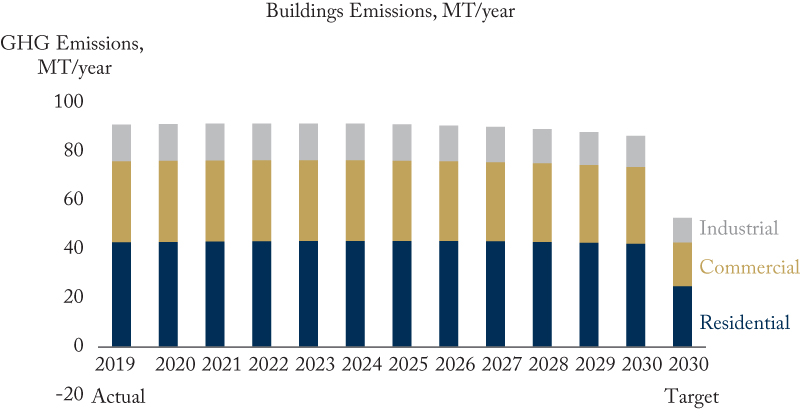To: The Hon. Steven Guilbeault, Minister of Environment and Climate Change
From: Brian Livingston
Date: December 15, 2022
Re: Counting Carbon III: A Reality Check on Our Emission Reduction Plan
This Intelligence Memo (IM) is the third in a series (see earlier IMs on transport and, oil and gas) dealing with the seven sectors of the Canadian economy that collectively make up all the greenhouse gas (GHG) emissions in Canada. This IM deals with the buildings sector. It complements an October 2022 IM by Charles DeLand on emissions from buildings, focused on residential housing. This earlier IM opined that Canada's emissions targets for buildings would not be met, but did not give a specific forecast. This IM attempts to make a specific numerical forecast for emissions from all buildings. The charts and spreadsheets underlying this work can be found here.
The buildings sector has three sub sectors, namely buildings for residential (houses as well as condominiums and apartments), commercial (offices, stores etc.) and industrial (factories, steel mills, power plants etc.).
The buildings sector accounted for 91 million tonnes (MT) of GHG emissions in 2019, about 12 percent of all GHG emissions in Canada. Ottawa has set a 2030 target of 53 MT, which will come from reductions in each of the three sub sectors as seen in the table below.

The largest portion of these reductions will have to come from the replacement of hydrocarbon powered furnaces and water heaters with electrical devices such as baseboard heaters, electric furnaces and heat pumps. Better insulation and retrofitting buildings with high efficiency natural gas furnaces will provide much smaller reductions.
Heat pumps powered by electricity literally pump heat from cold environments into buildings using the same principle as air conditioners or refrigerators. Heat pumps are often touted as the best bet for future energy needs for buildings, since they are the most efficient way of heating buildings.
Demand is the first challenge. Replacing furnaces with heat pumps or electric furnaces is not as visible nor as popular as buying an electric vehicle. Ottawa is trying to change this low uptake by offering grants of $5,000 to install a heat pump in residential units. It is also trying to change Building Codes so as to require new housing to use heat pumps or electricity as energy sources. The recent Economic Update in November of 2022 introduced a 30 percent investment tax credit for electric heating and heat pumps, presumably to encourage installation of these devices in commercial and industrial buildings.
Current annual installation in residential units is about 65,000 units per year for electricity heating and 20,000 for heat pumps. Commercial and industrial buildings have a lower uptake.
The second challenge is to turn over the existing fleet of buildings currently using hydrocarbon energy sources.
First, residential buildings. There are currently in Canada approximately 16 million units, of which 8.3 million are natural gas, 0.7 million are wood burning, 1.2 million are heating oil, 5 million are direct electric and 0.8 million are heat pumps. New residential unit construction is about 250,000 per year – 60 percent houses and 40 percent condos and apartments. I assume for the sake of my analysis that this increases at 2 percent per year from 2019 to 2030.
My model forecasts heat pump installation to grow at 25 percent per year. This is an aggressive number, but assumes that the government programs referred to above will cause this to occur.
This 25 percent growth assumption causes a forecast of annual installations in 2030 of 90,000 units per year supplied by electricity and 230,000 units per year supplied by heat pumps. The number of units in 2030 using hydrocarbon energy increases to 11.5 million units, since new housing units in the 2019 to 2030 period still exceed the increase in electricity and heat pump installations. I assume emissions per residential unit using hydrocarbon energy sources decrease by 1 percent a year due to better insulation and retrofitting of high efficiency natural gas furnaces. That leads to my forecast emissions in 2030 for residential units to be 42 MT versus the 25 MT target.
Next, commercial buildings. Commercial buildings in 2019 were about 760 million square meters in area, with virtually all of space and water heating requirements supplied by natural gas. The model uses a similar forecast of a 25 percent increase in installations of electric heating and heat pumps in 2030. Natural gas heating decreases to 93 percent of area while electric and heat pump heating increase to 7 percent of area. Emissions for commercial buildings are forecast to be 31 MT versus the 18 MT target.
Finally, industrial buildings. Industrial buildings in 2019 were about 185 million square meters in area, with virtually all of space and water heating requirements supplied by natural gas. The model uses a similar forecast of a 25 percent increase in installations of electric heating and heat pumps in 2030. Natural gas heating decreases to 76 percent of area while electric and heat pumps increase to 24 percent of area. Emissions for industrial buildings are forecast to be 13 MT versus the 10 MT target.
The bottom line is, the forecast for total buildings sector emissions in 2030 is 86 MT, 33 MT above the ERP target of 53 MT.

Brian Livingston is Executive Fellow at the School of Public Policy at the University of Calgary.
Counting Carbon is a four part series analyzing Canada's Emission Reduction Plan.
To read part one on Transportation, click here
To read part two on Oil and Gas, click here
To read part four on Heavy industry, electricity, agriculture and “waste and other,” click here
To send a comment or leave feedback, email us at blog@cdhowe.org.
The views expressed here are those of the author. The C.D. Howe Institute does not take corporate positions on policy matters.





